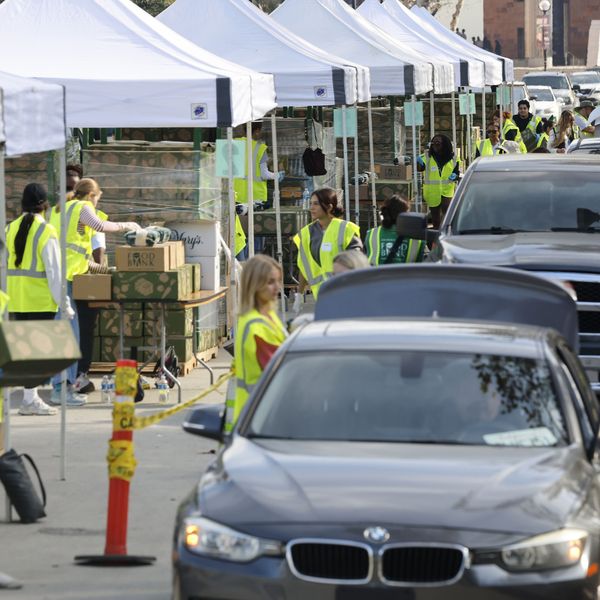
You might not know it from some of the economic headlines and cable news coverage, but Reich says "many are worse off due to the escalating costs of housing, healthcare, and education." And yes, it's time to start worrying about the next crash. (Image: inequalitymedia.org)
With GOP Once More Running Economy Into the Ground, Time to Start Worrying About the Next Crash
Ten years after the start of the Great Recession, it’s important to understand that the real root of the collapse wasn’t a banking crisis. It was the growing imbalance between consumer spending and total output – brought on by stagnant wages and widening inequality.
Sorry to deliver the news, but it's time to worry about the next crash.
The combination of stagnant wages with most economic gains going to the top is once again endangering the economy.
Most Americans are still living in the shadow of the Great Recession that started in December 2007 and officially ended in June 2009. More have jobs, to be sure. But they haven't seen any rise in their wages, adjusted for inflation.
Many are worse off due to the escalating costs of housing, healthcare, and education. And the value of whatever assets they own is less than in 2007.Which suggests we're careening toward the same sort of crash we had then, and possibly as bad as 1929.
Clear away the financial rubble from those two former crashes and you'd see they both followed upon widening imbalances between the capacity of most people to buy, and what they as workers could produce. Each of these imbalances finally tipped the economy over.
The same imbalance has been growing again. The richest 1 percent of Americans now takes home about 20 percent of total income, and owns over 40 percent of the nation's wealth.
These are close to the peaks of 1928 and 2007.
The underlying problem isn't that Americans have been living beyond their means. It's that their means haven't been keeping up with the growing economy. Most gains have gone to the top.
But the rich only spend a small fraction of what they earn. The economy depends on the spending of middle and working class families.
By the first quarter of this year, household debt was at an all-time high of $13.2 trillion. Almost 80 percent of Americans are now living paycheck to paycheck.
It was similar in the years leading up to the crash of 2007. Between 1983 and 2007, household debt soared while most economic gains went to the top. If the majority of households had taken home a larger share, they wouldn't have needed to go so deeply into debt.
Similarly, between 1913 and 1928, the ratio of personal debt to the total national economy nearly doubled. After the 1929 crash, the government invented new ways to boost wages - Social Security, unemployment insurance, overtime pay, a minimum wage, the requirement that employers bargain with labor unions, and, finally, a full-employment program called World War II.
After the 2007 crash, the government bailed out the banks and pumped enough money into the economy to contain the slide. But apart from the Affordable Care Act, nothing was done to address the underlying problem of stagnant wages.
Trump and his Republican enablers are now reversing regulations put in place to stop Wall Street's excessively risky lending.
But Trump's real contributions to the next crash are his sabotage of the Affordable Care Act, rollback of overtime pay, burdens on labor organizing, tax reductions for corporations and the wealthy but not for most workers, cuts in programs for the poor, and proposed cuts in Medicare and Medicaid - all of which put more stress on the paychecks of most Americans.
Ten years after the start of the Great Recession, it's important to understand that the real root of the collapse wasn't a banking crisis. It was the growing imbalance between consumer spending and total output - brought on by stagnant wages and widening inequality.
That imbalance is back. Watch your wallets.
An Urgent Message From Our Co-Founder
Dear Common Dreams reader, The U.S. is on a fast track to authoritarianism like nothing I've ever seen. Meanwhile, corporate news outlets are utterly capitulating to Trump, twisting their coverage to avoid drawing his ire while lining up to stuff cash in his pockets. That's why I believe that Common Dreams is doing the best and most consequential reporting that we've ever done. Our small but mighty team is a progressive reporting powerhouse, covering the news every day that the corporate media never will. Our mission has always been simple: To inform. To inspire. And to ignite change for the common good. Now here's the key piece that I want all our readers to understand: None of this would be possible without your financial support. That's not just some fundraising cliche. It's the absolute and literal truth. We don't accept corporate advertising and never will. We don't have a paywall because we don't think people should be blocked from critical news based on their ability to pay. Everything we do is funded by the donations of readers like you. Will you donate now to help power the nonprofit, independent reporting of Common Dreams? Thank you for being a vital member of our community. Together, we can keep independent journalism alive when it’s needed most. - Craig Brown, Co-founder |
Sorry to deliver the news, but it's time to worry about the next crash.
The combination of stagnant wages with most economic gains going to the top is once again endangering the economy.
Most Americans are still living in the shadow of the Great Recession that started in December 2007 and officially ended in June 2009. More have jobs, to be sure. But they haven't seen any rise in their wages, adjusted for inflation.
Many are worse off due to the escalating costs of housing, healthcare, and education. And the value of whatever assets they own is less than in 2007.Which suggests we're careening toward the same sort of crash we had then, and possibly as bad as 1929.
Clear away the financial rubble from those two former crashes and you'd see they both followed upon widening imbalances between the capacity of most people to buy, and what they as workers could produce. Each of these imbalances finally tipped the economy over.
The same imbalance has been growing again. The richest 1 percent of Americans now takes home about 20 percent of total income, and owns over 40 percent of the nation's wealth.
These are close to the peaks of 1928 and 2007.
The underlying problem isn't that Americans have been living beyond their means. It's that their means haven't been keeping up with the growing economy. Most gains have gone to the top.
But the rich only spend a small fraction of what they earn. The economy depends on the spending of middle and working class families.
By the first quarter of this year, household debt was at an all-time high of $13.2 trillion. Almost 80 percent of Americans are now living paycheck to paycheck.
It was similar in the years leading up to the crash of 2007. Between 1983 and 2007, household debt soared while most economic gains went to the top. If the majority of households had taken home a larger share, they wouldn't have needed to go so deeply into debt.
Similarly, between 1913 and 1928, the ratio of personal debt to the total national economy nearly doubled. After the 1929 crash, the government invented new ways to boost wages - Social Security, unemployment insurance, overtime pay, a minimum wage, the requirement that employers bargain with labor unions, and, finally, a full-employment program called World War II.
After the 2007 crash, the government bailed out the banks and pumped enough money into the economy to contain the slide. But apart from the Affordable Care Act, nothing was done to address the underlying problem of stagnant wages.
Trump and his Republican enablers are now reversing regulations put in place to stop Wall Street's excessively risky lending.
But Trump's real contributions to the next crash are his sabotage of the Affordable Care Act, rollback of overtime pay, burdens on labor organizing, tax reductions for corporations and the wealthy but not for most workers, cuts in programs for the poor, and proposed cuts in Medicare and Medicaid - all of which put more stress on the paychecks of most Americans.
Ten years after the start of the Great Recession, it's important to understand that the real root of the collapse wasn't a banking crisis. It was the growing imbalance between consumer spending and total output - brought on by stagnant wages and widening inequality.
That imbalance is back. Watch your wallets.
Sorry to deliver the news, but it's time to worry about the next crash.
The combination of stagnant wages with most economic gains going to the top is once again endangering the economy.
Most Americans are still living in the shadow of the Great Recession that started in December 2007 and officially ended in June 2009. More have jobs, to be sure. But they haven't seen any rise in their wages, adjusted for inflation.
Many are worse off due to the escalating costs of housing, healthcare, and education. And the value of whatever assets they own is less than in 2007.Which suggests we're careening toward the same sort of crash we had then, and possibly as bad as 1929.
Clear away the financial rubble from those two former crashes and you'd see they both followed upon widening imbalances between the capacity of most people to buy, and what they as workers could produce. Each of these imbalances finally tipped the economy over.
The same imbalance has been growing again. The richest 1 percent of Americans now takes home about 20 percent of total income, and owns over 40 percent of the nation's wealth.
These are close to the peaks of 1928 and 2007.
The underlying problem isn't that Americans have been living beyond their means. It's that their means haven't been keeping up with the growing economy. Most gains have gone to the top.
But the rich only spend a small fraction of what they earn. The economy depends on the spending of middle and working class families.
By the first quarter of this year, household debt was at an all-time high of $13.2 trillion. Almost 80 percent of Americans are now living paycheck to paycheck.
It was similar in the years leading up to the crash of 2007. Between 1983 and 2007, household debt soared while most economic gains went to the top. If the majority of households had taken home a larger share, they wouldn't have needed to go so deeply into debt.
Similarly, between 1913 and 1928, the ratio of personal debt to the total national economy nearly doubled. After the 1929 crash, the government invented new ways to boost wages - Social Security, unemployment insurance, overtime pay, a minimum wage, the requirement that employers bargain with labor unions, and, finally, a full-employment program called World War II.
After the 2007 crash, the government bailed out the banks and pumped enough money into the economy to contain the slide. But apart from the Affordable Care Act, nothing was done to address the underlying problem of stagnant wages.
Trump and his Republican enablers are now reversing regulations put in place to stop Wall Street's excessively risky lending.
But Trump's real contributions to the next crash are his sabotage of the Affordable Care Act, rollback of overtime pay, burdens on labor organizing, tax reductions for corporations and the wealthy but not for most workers, cuts in programs for the poor, and proposed cuts in Medicare and Medicaid - all of which put more stress on the paychecks of most Americans.
Ten years after the start of the Great Recession, it's important to understand that the real root of the collapse wasn't a banking crisis. It was the growing imbalance between consumer spending and total output - brought on by stagnant wages and widening inequality.
That imbalance is back. Watch your wallets.

